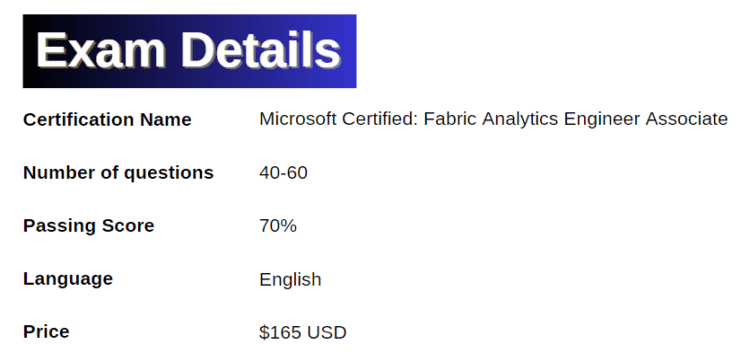Exam DP-600: Implementing Analytics Solutions Using Microsoft Fabric

As a candidate preparing for the Exam DP-600: Implementing Analytics Solutions Using Microsoft Fabric, it’s crucial to possess expertise in designing, creating, and deploying large-scale data analytics solutions. In this role, your responsibilities involve converting data into reusable analytics assets using Microsoft Fabric components like Lakehouses, Data Warehouses, Notebooks, Dataflows, Data Pipelines, Semantic Models, and Reports. You’ll be implementing analytics best practices within Fabric, which includes incorporating version control and ensuring proper deployment.
Knowledge required:
- To excel as a Fabric analytics engineer, collaboration with other roles is essential. This includes working closely with Solution Architects, Data Engineers, Data Scientists, AI Engineers, and Database Administrators, as well as Power BI Data Analysts.
- Aside from mastering the Fabric platform, hands-on experience in data modeling, data transformation, Git-based source control, exploratory analytics, and proficiency in languages such as SQL, DAX, and PySpark are also required for success in this role.
Exam Details

Successfully passing the Exam DP-600: Implementing Analytics Solutions Using Microsoft Fabric will qualify you to attain the esteemed title of Microsoft Certified: Fabric Analytics Engineer Associate. The exam is conducted in English, comprises 40-60 questions, requires a passing score of 700, and the registration fee is $165 USD.
Course Outline
Preparing for the exam requires a solid understanding of the course outline, serving as a guide to acquiring essential skills and knowledge. Understanding the exam curriculum guarantees a comprehensive grasp of the subjects at hand. Let’s now examine the key areas covered in the DP-600 exam.

1. Understand about planning, implementing, and managing solution for data analytics (10–15%)
Planning a data analytics environment
- Identifying requirements for a solution, including components, features, performance, and capacity stock-keeping units (SKUs) (Microsoft Documentation: Capacity and SKUs in Power BI embedded analytics, Recommendations for selecting the right services)
- Recommending settings in the Fabric admin portal (Microsoft Documentation: Tenant settings index, What is the admin portal?)
- Choosing a data gateway type (Microsoft Documentation: Add or remove a gateway data source, What is an on-premises data gateway?)
- Creating a custom Power BI report theme (Microsoft Documentation: Use report themes in Power BI Desktop, Use dashboard themes in the Power BI service)
Implementing and managing a data analytics environment
- Implementing workspace and item-level access controls for Fabric items (Microsoft Documentation: Share items in Microsoft Fabric, Security for data warehousing in Microsoft Fabric)
- Implementing data sharing for workspaces, warehouses, and lakehouses (Microsoft Documentation: Data Warehouse sharing, How lakehouse sharing works)
- Managing sensitivity labels in semantic models and lakehouses (Microsoft Documentation: Learn about sensitivity labels)
- Configuring Fabric-enabled workspace settings (Microsoft Documentation: Workspaces, Workspace tenant settings)
- Managing Fabric capacity (Microsoft Documentation: Manage capacity settings)
Managing the analytics development lifecycle
- Implementing version control for a workspace (Microsoft Documentation: Version control, metadata search, and navigation)
- Creating and managing a Power BI Desktop project (.pbip) (Microsoft Documentation: Power BI Desktop projects (PREVIEW))
- Planning and implementing deployment solutions (Microsoft Documentation: Planning the Deployment)
- Performing impact analysis of downstream dependencies from lakehouses, data warehouses, dataflows, and semantic models (Microsoft Documentation: Semantic model impact analysis)
- Deploying and managing semantic models by using the XMLA endpoint (Microsoft Documentation: Semantic model connectivity with the XMLA endpoint)
- Creating and updating reusable assets, including Power BI template (.pbit) files, Power BI data source (.pbids) files, and shared semantic models (Microsoft Documentation: Create and use report templates in Power BI Desktop, Semantic models in the Power BI service)
2. Learn how to prepare and serve data (40–45%)
Creating objects in a lakehouse or warehouse
- Ingesting data by using a data pipeline, dataflow, or notebook (Microsoft Documentation: Use a dataflow in a pipeline)
- Creating and managing shortcuts
- Implementing file partitioning for analytics workloads in a lakehouse (Microsoft Documentation: Load data to Lakehouse using partition in a Data pipeline)
- Creating views, functions, and stored procedures
- Enriching data by adding new columns or tables (Microsoft Documentation: Data collection transformations in Azure Monitor)
Copying data
- Choosing an appropriate method for copying data from a Fabric data source to a lakehouse or warehouse (Microsoft Documentation: How to copy data using copy activity, Options to get data into the Fabric Lakehouse)
- Copying data by using a data pipeline, dataflow, or notebook (Microsoft Documentation: Use the copy data tool in the Azure Data Factory Studio to copy data)
- Adding stored procedures, notebooks, and dataflows to a data pipeline (Microsoft Documentation: Transform data by using the SQL Server Stored Procedure activity in Azure Data Factory or Synapse Analytics, Pipelines and activities in Azure Data Factory and Azure Synapse Analytics)
- Scheduling data pipelines (Microsoft Documentation: Create a trigger that runs a pipeline on a schedule)
- Scheduling dataflows and notebooks Data flows in Azure Synapse Analytics (Microsoft Documentation: Data flows in Azure Synapse Analytics)
Transforming data
- Implementing a data cleansing process (Microsoft Documentation: Data Cleansing)
- Implementing a star schema for a lakehouse or warehouse, including Type 1 and Type 2 slowly changing dimensions (Microsoft Documentation: Understand star schema and the importance for Power BI)
- Implementing bridge tables for a lakehouse or a warehouse
- Denormalizing data (Microsoft Documentation: Modeling for Performance)
- Aggregating or de-aggregating data (Microsoft Documentation: User-defined aggregations)
- Merging or joining data (Microsoft Documentation: Merge queries (Power Query))
- Identifying and resolving duplicate data, missing data, or null values (Microsoft Documentation: Set up duplicate detection rules to keep your data clean)
- Converting data types by using SQL or PySpark (Microsoft Documentation: Load and transform data in PySpark DataFrames)
- Filtering data
Optimizing performance
- Identifying and resolving data loading performance bottlenecks in dataflows, notebooks, and SQL queries (Microsoft Documentation: Identify Bottlenecks)
- Implementing performance improvements in dataflows, notebooks, and SQL queries
- Identifying and resolving issues with Delta table file sizes (Microsoft Documentation: Configure Delta Lake to control data file size, Use Delta Lake change data feed on Azure Databricks)
3. Understanding implementing and managing semantic models (20–25%)
Designing and building semantic models
- Choosing a storage mode, including Direct Lake (Microsoft Documentation: Direct Lake)
- Identifying use cases for DAX Studio and Tabular Editor 2 (Microsoft Documentation: DAX overview)
- Implementing a star schema for a semantic model (Microsoft Documentation: Understand star schema and the importance for Power BI)
- Implementing relationships, such as bridge tables and many-to-many relationships (Microsoft Documentation: Many-to-many relationship guidance)
- Writing calculations that use DAX variables and functions, such as iterators, table filtering, windowing, and information functions (Microsoft Documentation: Use variables to improve your DAX formulas)
- Implementing calculation groups, dynamic strings, and field parameters (Microsoft Documentation: Calculation groups)
- Designing and building a large format dataset (Microsoft Documentation: Datasets larger than 10 GB in Power BI Premium)
- Designing and building composite models that include aggregations (Microsoft Documentation: Use composite models in Power BI Desktop)
- Implementing dynamic row-level security and object-level security (Microsoft Documentation: Row-level security (RLS) with Power BI)
- Validating row-level security and object-level security (Microsoft Documentation: Row-level security (RLS) guidance in Power BI Desktop)
Optimizing enterprise-scale semantic models
- Implementing performance improvements in queries and report visuals (Microsoft Documentation: Optimization guide for Power BI)
- Improving DAX performance by using DAX Studio (Microsoft Documentation: Performance Tuning DAX )
- Optimizing a semantic model by using Tabular Editor 2 (Microsoft Documentation: External tools in Power BI Desktop)
- Implementing incremental refresh (Microsoft Documentation: Incremental refresh and real-time data for semantic models)
4. Understand how to explore and analyze data (20–25%)
Performing exploratory analytics
- Implementing descriptive and diagnostic analytics
- Integrating prescriptive and predictive analytics into a visual or report
- Profiling data (Microsoft Documentation: Using the data profiling tools)
Querying data by using SQL
- Querying a lakehouse in Fabric by using SQL queries or the visual query editor (Microsoft Documentation: Query using the visual query editor)
- Querying a warehouse in Fabric by using SQL queries or the visual query editor (Microsoft Documentation: Query using the SQL query editor)
- Connecting to and querying datasets by using the XMLA endpoint
Microsoft DP-600 Exam FAQs
Exam Policies
All the details about the exam, including its procedures, can be found in the Microsoft Certification exam policies. It’s crucial to follow these guidelines both during the exam and when you’re at the test center. Let’s take a closer look at some of these rules:
Retaking the Exam: If you don’t pass on your first attempt, wait for 24 hours before attempting again. During this time, you can choose a new exam date on the certification dashboard. After the second attempt, there’s a 14-day waiting period. After the third attempt, there are 14-day intervals between each try. You are allowed up to five attempts per year, and the 12-month period begins from your initial try.
Changing Exam Date or Cancelling: If you need to modify or cancel your exam, ensure you do so at least 24 hours before your scheduled time. Any changes made within 24 hours will result in the forfeiture of the exam fee. Additionally, if your company provided a voucher for the exam, they may incur penalties if you make changes or cancellations with less than 24 hours notice.
Study Guide for Microsoft DP-600 Exam

1. Understanding Exam Goals
To initiate your preparation for the Microsoft DP-600 exam, it’s crucial to comprehend the exam objectives. These goals delve into fundamental topics that form the core of what you need to know. The exam assesses your technical skills in accomplishing specific tasks:
- Planning, implementing, and managing a solution for data analytics
- Preparing and serving data
- Implementing and managing semantic models
- Exploring and analyzing data
2. Microsoft Learning Paths
Microsoft offers distinct learning paths equipped with study modules to prepare you for your exams. For a comprehensive guide and study resources for the DP-600 test, visit the official Microsoft website. The modules in this course not only enhance your understanding of the subjects but also ensure your success in the exams. Here’s what the learning path for the test includes:
– Ingest data with Microsoft Fabric
For more: https://learn.microsoft.com/en-us/training/paths/ingest-data-with-microsoft-fabric/
Discover how Microsoft Fabric empowers you to gather and organize data from different sources, including files, databases, or web services, using dataflows, notebooks, and pipelines.
Modules in this learning path:
- Ingesting Data with Dataflows Gen2 in Microsoft Fabric
- Ingesting data with Spark and Microsoft Fabric notebooks
- Using Data Factory pipelines in Microsoft Fabric
– Implementing a Lakehouse with Microsoft Fabric
For more: https://learn.microsoft.com/en-us/training/paths/implement-lakehouse-microsoft-fabric/
This learning path help you understand the basic components of implementing a data lakehouse with Microsoft Fabric.
Modules in this learning path:
- End-to-end analytics using Microsoft Fabric
- Lakehouses in Microsoft Fabric
- Using Apache Spark in Microsoft Fabric
- Working with Delta Lake tables in Microsoft Fabric
- Ingesting Data with Dataflows Gen2 in Microsoft Fabric
- Using Data Factory pipelines in Microsoft Fabric
- Organizing a Fabric lakehouse using medallion architecture design
– Working with data warehouses using Microsoft Fabric
For more: https://learn.microsoft.com/en-us/training/paths/work-with-data-warehouses-using-microsoft-fabric/
Get familiarity with the data warehousing process and understand how to load, monitor, and query a warehouse in Microsoft Fabric.
Modules in this learning path:
- Data warehouses in Microsoft Fabric
- Loading data into a Microsoft Fabric data warehouse
- Querying a data warehouse in Microsoft Fabric
- Monitoring a Microsoft Fabric data warehouse
– Working with semantic models in Microsoft Fabric
For more: https://learn.microsoft.com/en-us/training/paths/work-semantic-models-microsoft-fabric/
Creating reports for large-scale businesses involves more than just linking to data. Success in enterprise-level implementation requires a grasp of semantic models and effective strategies for scalability and optimization.
Modules in this learning path:
- Understanding scalability in Power BI
- Creating Power BI model relationships
- Using tools to optimize Power BI performance
- Enforcing Power BI model security
– Designing and building tabular models
For more: https://learn.microsoft.com/en-us/training/paths/design-build-tabular-models/
This learning path helps you get familiar with the foundational components of designing scalable tabular models using Power BI.
Modules in this learning path:
- Creating Power BI model relationships
- Using DAX time intelligence functions in Power BI Desktop models
- Creating calculation groups
- Enforcing Power BI model security
- Using tools to optimize Power BI performance
– Managing the analytics development lifecycle
For more: https://learn.microsoft.com/en-us/training/paths/manage-analytics-development-lifecycle/
This learning path provides an understanding of the basic components of implementing lifecycle management techniques for Power BI assets.
Modules in this learning path:
- Designing a Power BI application lifecycle management strategy
- Creating and managing a Power BI deployment pipeline
- Creating and managing Power BI assets
3. Participate in Study Communities
Making exam preparations becomes much smoother when you become part of online study groups. These communities connect you with experienced individuals who have faced similar challenges. It’s a chance to discuss any concerns you may have about the test and get ready for the DP-600 exam. So, it’s more than just studying; it’s learning from those who have already walked the path.
4. Use Practice Tests
Practice tests play a vital role in reinforcing your understanding of the study material. When you engage with Microsoft DP-600 practice exams, you can pinpoint your strengths and areas that require more attention. It’s like getting a sneak peek into your study progress. Moreover, these tests improve your speed in answering questions, providing a significant advantage on the actual exam day. Once you’ve covered a substantial amount of material, incorporating these practice tests for the exam is a wise decision. It’s not just about practicing; it’s about maximizing the effectiveness of your study time.



